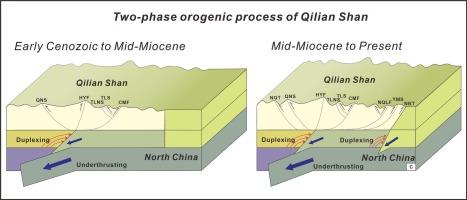陆内逆冲作用和下地壳复叠作用驱动祁连山隆升
IF 7.2
1区 地球科学
Q1 GEOSCIENCES, MULTIDISCIPLINARY
引用次数: 0
摘要
陆内造山运动背景下的地壳缩短增厚机制一直是板块构造理论研究的热点。特别是祁连山的隆升,是一个由于新生代印度-亚洲板块碰撞的远场影响而经历隆升的板内造山系统,仍然是一个持续争论的主题。在这项研究中,我们首先报告了两个ne向的大炸药射击的深部地震反射剖面,整个祁连山总共约400公里。这两条剖面提供了南祁连山和北祁连山岩石圈结构的高分辨率成像。结果表明,祁连山中下地壳内存在两组明显的南倾反射,并由两条向北的大型逆冲断层发育。南祁连山下为逆冲断裂伴中地壳复式构造,北祁连山下为中下地壳复式构造。此外,这些反射抵消了莫霍面,并从下地壳延伸到上地幔。通过将我们的地震发现与现有的年代学数据以及先前的地质和地球物理研究相结合,我们提出印度-亚洲碰撞的远场影响导致了祁连山下的华北克拉通被动向南逆冲的两个不同阶段。这两个阶段连同中、下地壳中多个复式构造的形成,对祁连山新生代地壳的缩短和增厚起了关键作用。祁连山在中新世中期整体上经历了显著的隆升,随后在1 ~ 4 Ma之间向河西走廊扩展。本文章由计算机程序翻译,如有差异,请以英文原文为准。

Intracontinental underthrusting and lower crustal duplexing drive the uplift of the Qilian Shan
The mechanism driving crustal shortening and thickening under the background of intracontinental orogeny has long been a focal point in plate tectonic theory. In particular, the uplift of the Qilian Shan, an intraplate orogenic system that experienced uplift due to the far-field effects of the India–Asia plate collision during the Cenozoic, remains a subject of ongoing debate. In this study, we first report two NE-trending deep seismic reflection profiles of large dynamite shots, totaling ∼400 km across the entire Qilian Shan. These two profiles provide high-resolution imaging of the lithospheric architecture beneath the South Qilian Shan and North Qilian Shan. Our results reveal two sets of prominent south-dipping reflections within the middle-lower crust of the Qilian Shan, which are accommodated by two large northward thrust faults. These south-dipping reflections are interpreted as a thrust fault system accompanied by middle-crustal duplexes beneath the South Qilian Shan, while beneath the North Qilian Shan, they represent the middle-lower crustal duplex structures. Additionally, these reflections offset the Moho and extend from the lower crust into the upper mantle. By integrating our seismic findings with available chronological data and prior geological and geophysical research, we propose that the far-field effects of the India–Asia collision induced two distinct phases of passive southward underthrusting of the North China Craton beneath the Qilian Shan. These two phases, along with the formation of multiple duplex structures in the middle-lower crust, played a pivotal role in the Cenozoic crustal shortening and thickening of the Qilian Shan. The Qilian Shan experienced significant uplift as a whole during the mid-Miocene and subsequently expanded towards the Hexi Corridor between 1 and 4 Ma.
求助全文
通过发布文献求助,成功后即可免费获取论文全文。
去求助
来源期刊

Gondwana Research
地学-地球科学综合
CiteScore
12.90
自引率
6.60%
发文量
298
审稿时长
65 days
期刊介绍:
Gondwana Research (GR) is an International Journal aimed to promote high quality research publications on all topics related to solid Earth, particularly with reference to the origin and evolution of continents, continental assemblies and their resources. GR is an "all earth science" journal with no restrictions on geological time, terrane or theme and covers a wide spectrum of topics in geosciences such as geology, geomorphology, palaeontology, structure, petrology, geochemistry, stable isotopes, geochronology, economic geology, exploration geology, engineering geology, geophysics, and environmental geology among other themes, and provides an appropriate forum to integrate studies from different disciplines and different terrains. In addition to regular articles and thematic issues, the journal invites high profile state-of-the-art reviews on thrust area topics for its column, ''GR FOCUS''. Focus articles include short biographies and photographs of the authors. Short articles (within ten printed pages) for rapid publication reporting important discoveries or innovative models of global interest will be considered under the category ''GR LETTERS''.
 求助内容:
求助内容: 应助结果提醒方式:
应助结果提醒方式:


